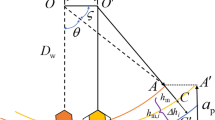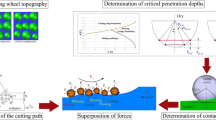Abstract
In the research on grinding process modeling, the stochastic nature of grain sizes and locations need to be considered. A new numerical model was developed which will describe the micro-interacting situations between grains and workpiece material in grinding contact zone. The model was established based on a series of reasonable assumptions, the critical conditions of starting points of plowing and cutting stages, and the redefined grinding contact zone. It indicated that there are four types of grain existing in grinding contact zone: uncontact, sliding, plowing, and cutting grains. The number of grains per unit wheel volume (N v ) and the undeformed chip thickness (h cu,max), which are key parameters in grinding process modeling, were firstly obtained. The numbers and distributions of different grain types along grinding contact zone were then obtained and analyzed. Calculation results showed that only a small fraction of grains participate in cutting interactions and the changing laws of each grain types along grinding contact length are very different from each other, which gives a deeper insight into grinding process and can be a good foundation for more precise grinding force prediction and thermal analysis. Another important application of this model is for ground surface roughness prediction and a new method on this purpose was developed. At last, two comparisons were made between calculation results and existing experimental data for validating the work on paper. Comparison results showed that the roughness of ground surface can be well predicted and gave the method theoretically to reduce ground surface roughness.
Similar content being viewed by others
References
Zhou X, Xi F (2002) Modeling and predicting surface roughness of the grinding process. Int J Mach Tools Manuf 42:969–977
Hou ZB, Komanduri R (2003) On the mechanics of the grinding process—part I. Stochastic nature of the grinding process. Int J Mach Tools Manuf 43:1579–1593
Chang HC, Wang JJJ (2008) A stochastic grinding force model considering random grit distribution. Int J Mach Tools Manuf 48:1335–1344
Hecker RL, Ramoneda IM, Liang SY (2003) Analysis of wheel topography and grain force for grinding process modeling. J Manuf Process 5:13–23
Hecker RL, Liang SY, Wu XJ, Xia P, Jin DGW (2007) Grinding force and power modeling based on chip thickness analysis. Int J Adv Manuf Technol 33:449–459
Park HW, Liang SY, Chen R (2007) Microgrinding force predictive modelling based on microscale single grain interaction analysis. Int J Manuf Technol Manag 12:25–38
Agarwal S, Rao PV (2010) Modeling and prediction of surface roughness in ceramic grinding. Int J Mach Tools Manuf 50:1065–1076
Aurich JC, Herzenstiel P, Sudermann H, Magg T (2008) High-performance dry grinding using a grinding wheel with a defined grain pattern. CIRP Ann Manuf Technol 57:357–362
Tso PL, Wu SH (1999) Analysis of grinding quantities through chip sizes. J Mater Process Technol 95:1–7
Malkin S (1989) Grinding technology: theory and applications of machining with abrasives. Wiley, New York
Agarwal S, Rao PV (2012) Predictive modeling of undeformed chip thickness in ceramic grinding. Int J Mach Tools Manuf 56:59–68
Norton Company (1978) Standard stock and specifications manual
Hwang TW, Evens CJ (2000) High speed grinding of silicon nitride with electroplated diamond wheels, part 1: wear and wheel life. J Manuf Sci Eng -Trans ASME 122:32–41
Blunt L, Ebdon S (1996) The application of three-dimensional surface measurement techniques to characterizing grinding wheel topography. Int J Mach Tools Manuf 36:1207–1226
Yan L, Rong YM, Jiang F, Zhou ZX (2011) Three-dimension surface characterization of grinding wheel using white light interferometer. Int J Adv Manuf Technol 55:133–141
Marinescu ID, Rowe WB, Dimitrov B, Inasaki I (2004) Tribology of abrasive machining processes. Andrew, Norwich
Qi HS, Mills B, Rowe WB (1994) An analysis of real contact length in abrasive machining processes using contact mechanics. Wear 176:137–141
Zhou ZX, Van Lutterwelt CA (1992) The real contact length between grinding wheel and workpiece—a new concept and a new measuring method. CIRP Ann Manuf Technol 41:387–391
Pombo I, Sánchez JA, Ortega N, Marquínez JI, Izquierdo B, Plaza S (2012) Contact length estimation in grinding using thermocouple measurement and numerical simulation. Int J Adv Manuf Technol 59:83–91
Huang H, Yin L, Zhou L (2003) High speed grinding of silicon nitride with resin bond diamond wheels. J Mater Process Technol 141:329–336
Shanawaz AM, Sundaram S, Pillai UTS, Aurtherson PB (2011) Grinding of aluminium silicon carbide metal matrix composite materials by electrolytic in-process dressing grinding. Int J Adv Manuf Technol 57:143–150
Young HT, Chen DJ (2006) Online dressing of profile grinding wheels. Int J Adv Manuf Technol 27:883–888
Inasaki I (1996) Grinding process simulation based on the wheel topography measurement. CIRP Ann Manuf Technol 45:347–350
Badger JA, Torrance AA (2000) A comparison of two models to predict grinding forces from wheel surface topography. Int J Mach Tools Manuf 40:1099–1120
Baseri H (2012) Simulated annealing based optimization of dressing conditions for increasing the grinding performance. Int J Adv Manuf Technol 59:531–538
Author information
Authors and Affiliations
Corresponding author
Rights and permissions
About this article
Cite this article
Jiang, J., Ge, P. & Hong, J. Study on micro-interacting mechanism modeling in grinding process and ground surface roughness prediction. Int J Adv Manuf Technol 67, 1035–1052 (2013). https://doi.org/10.1007/s00170-012-4546-9
Received:
Accepted:
Published:
Issue Date:
DOI: https://doi.org/10.1007/s00170-012-4546-9




